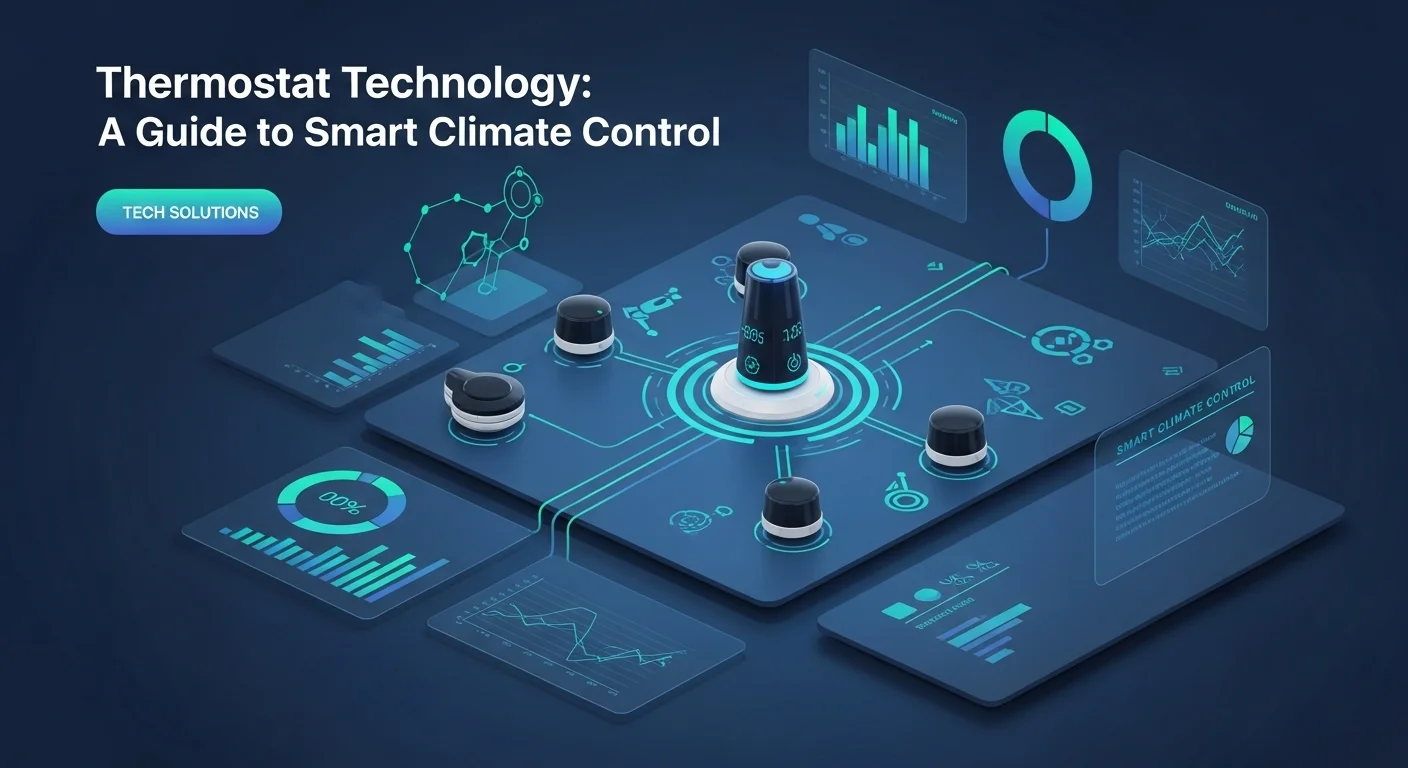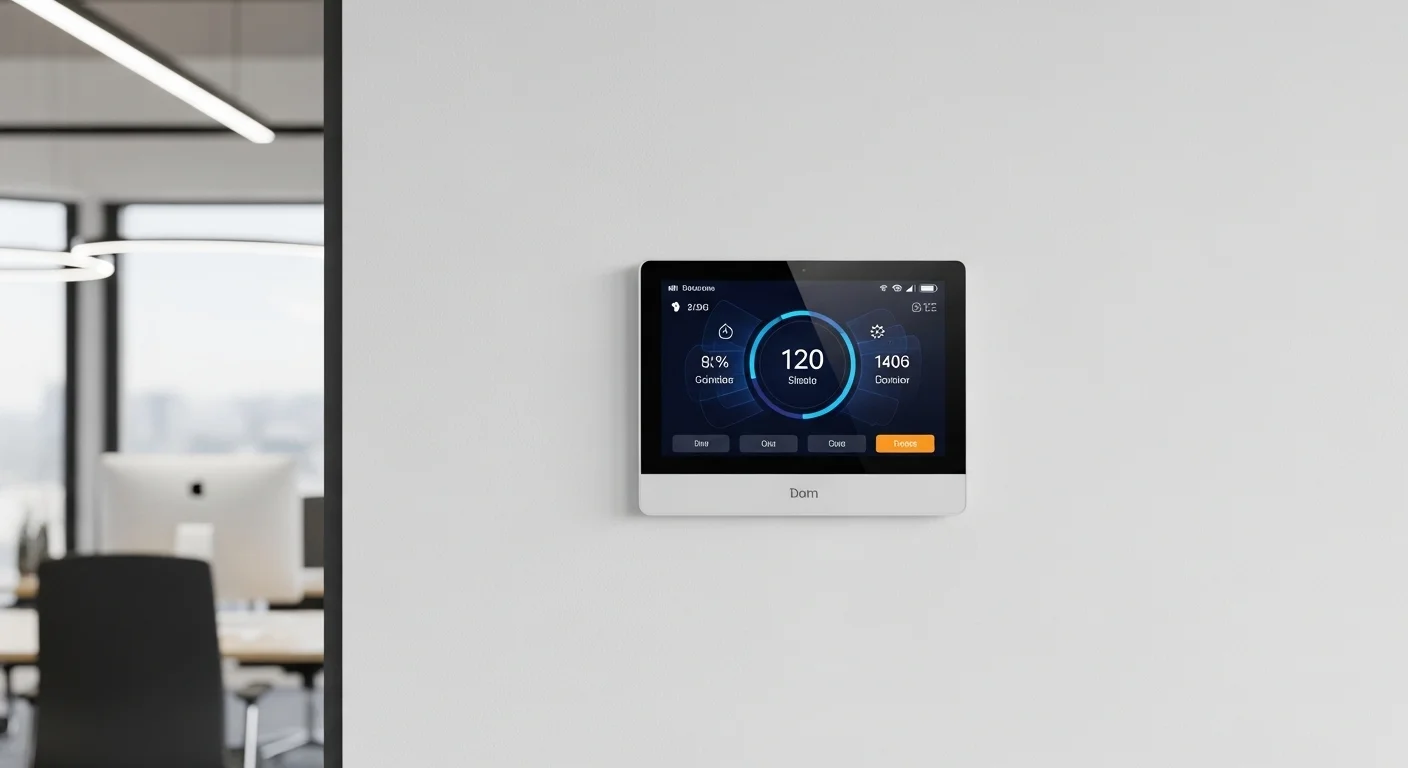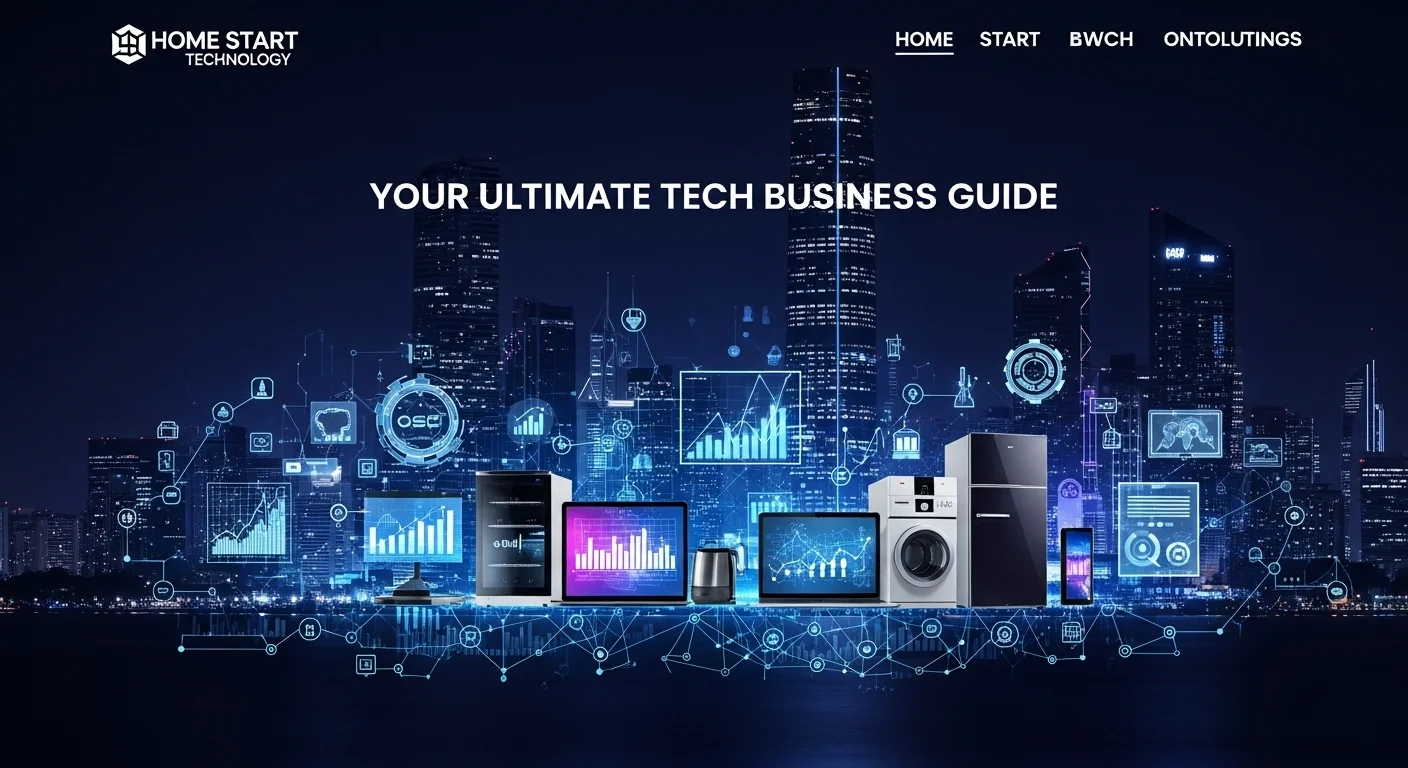Smart Thermostats Explained: A Real-World Guide to Saving Energy and Money

Executive Summary
I remember the old mercury thermostat in my childhood home—that simple beige dial on the wall. We thought it was amazing that we could set the temperature. Now, look at where we are. That simple dial has evolved into a sleek, intelligent hub at the heart of the smart home. This isn't just about not having to get off the couch anymore; it's a fundamental change in how we manage energy, automate our homes, and run our businesses. For tech lovers like me, it's a fantastic world of integration with platforms like Home Assistant. For businesses, it's a game-changer for cutting costs and boosting comfort. In this guide, I'm going to walk you through everything I've learned over the years. We'll explore the tech that makes them tick, like Z-Wave and Zigbee, and the AI that learns your every move. I'll give you a complete roadmap for picking, installing, and getting the most out of these systems, whether for your living room or your entire office building. Let's make your space smarter, more efficient, and perfectly comfortable.
Table of Contents
What You'll Learn in This Guide
- What is a Smart Thermostat and Why Does It Matter?
- The Tech Behind the Scenes: Protocols Explained
- Unleashing True Control with Automation Platforms
- Smart Thermostats for Business: Scaling Up
- Head-to-Head: Choosing the Right System for You
- Getting the Basics Right: Best Practices for Performance
- Next-Level Control: Advanced Automation Strategies
What is a Smart Thermostat and Why Does It Matter?
The journey of the thermostat is one of my favorite stories in tech. It started with a simple mechanical concept: a strip of metal that would physically bend with heat to complete a circuit, clicking the furnace on or off. It was beautifully simple, but it wasn't smart. The first real step forward was the programmable thermostat. I remember installing my first one and feeling like a genius because I could tell it to cool down the house before I got home from work. That basic automation was the seed for today's revolution.
Today’s smart thermostats are essentially small, powerful computers for your wall. They are packed with sensors—not just for temperature, but for humidity, light, and even whether you're in the room using motion detectors. They connect to your Wi-Fi or other networks like Zigbee and Z-Wave, which is what truly unlocks their potential. This connection allows you to control them from your phone, talk to them via Alexa or Google Assistant, and most importantly, it allows them to learn. This is where AI comes in. Systems like the Google Nest are famous for their learning algorithms. They watch you. They notice you turn the heat down every night around 10 PM and, after a few days, they just start doing it for you. They even check the weather forecast to pre-cool your home more efficiently before a heatwave hits. This constant learning is what makes an automated thermostat so brilliant at saving energy without sacrificing comfort.
The impact of this technology is huge, both for our wallets and our daily lives. At home, the promise of cutting your heating and cooling bills by 10-25% is a huge draw. But honestly, for me, the convenience is just as valuable. The feeling of walking into a perfectly cool house on a sweltering day, without ever touching the dial, is a small luxury that makes a big difference. For the real tech enthusiasts, the fun starts when you integrate the thermostat into your wider smart home. This is where you get into creating powerful routines, like homekit thermostat automation or using the incredibly flexible home assistant nest thermostat automation. I've set up routines where my 'Goodbye' scene not only lowers the heat but also turns off the lights, locks the doors, and arms the security system. The thermostat becomes the conductor of a smart home orchestra.
For businesses, the stakes are even higher. HVAC is a massive energy hog in commercial buildings, often eating up nearly half the electricity bill. A network of smart thermostats gives a facility manager god-like control from a single screen. No more walking around adjusting dozens of units. No more wasting money air-conditioning an empty conference room all weekend. The data these systems provide is pure gold, showing exactly where energy is being used and how to cut back. When a business looks for the best smart home thermostat system, they're looking for things like scalability and security. Systems using robust mesh networks like Z-Wave are often preferred, which is why having practical knowledge of things like honeywell z wave thermostat programming is so valuable for custom business setups. Imagine a system that syncs with employee schedules and occupancy sensors to create a perfectly efficient and comfortable workspace. That's not the future; it's what's happening right now.

Complete guide to Thermostat in Technology and Business Solutions
Going beyond the surface of smart thermostats means getting your hands dirty with the underlying tech, business cases, and what really separates one system from another. Whether you’re a homeowner trying to pick the right device or a business manager planning a large-scale deployment, this is the deep-dive knowledge you need to make the right call.
The Tech Behind the Scenes: Protocols Explained
A smart device is only as good as its ability to communicate. The protocol it uses is like the language it speaks, and it determines everything from battery life to reliability.
- Wi-Fi: Everyone knows Wi-Fi. It's easy because it connects directly to your internet router. The downside is that it's power-hungry. Think of it like a sports car—fast and powerful, but it burns through fuel. This is why many Wi-Fi thermostats need a dedicated power line (the 'C-wire').
- Zigbee: This is a low-power mesh network. 'Mesh' is the key word here. Instead of every device shouting back to the router, they can whisper to each other, passing the message along. This creates a stronger, more reliable network that's great for battery-powered sensors. It does operate on the busy 2.4 GHz frequency, which can sometimes feel like trying to have a conversation at a loud party.
- Z-Wave: My personal favorite for reliability. Z-Wave is another mesh network, but it operates on a much quieter, lower-frequency band. It’s like having a private, uncongested lane on the highway. This is why it's a top choice for security systems and pro installers. When you hear about honeywell z wave thermostat programming, it's because pros use it to build rock-solid, customized systems.
- Thread: This is one of the newer players, designed to be the best of all worlds. It's a low-power, self-healing mesh network like Z-Wave and Zigbee, but it's built on the same foundation as the internet (IP), which simplifies things. It’s a huge part of the new Matter standard.
- Matter: Think of Matter as a universal translator. For years, a Google device couldn't easily talk to an Apple device. Matter aims to fix that. If a thermostat is 'Matter-certified,' it should work seamlessly with any Matter-certified controller (Apple Home, Google Home, etc.). This is a huge step forward for all of us.
Unleashing True Control with Automation Platforms
A smart thermostat on its own is cool. A smart thermostat integrated into a larger platform is where the magic happens. This is how you move from simple schedules to true home intelligence.
I've found that HomeKit thermostat automation is fantastic for those in the Apple ecosystem. It’s incredibly secure and private, with a lot of the processing happening locally on your Apple TV or HomePod. Setting up automations in the Home app is a breeze. I have a 'Good Night' scene that I just tell Siri to run. It sets my thermostat to 68 degrees, locks my front door, and turns off all the main lights. It's simple, reliable, and just works.
For those who want ultimate power and don't mind a bit of tinkering, there is nothing like Home Assistant. It's open-source, runs locally in your home (I run mine on a Raspberry Pi), and puts your privacy first. It can connect to almost anything. Setting up home assistant nest thermostat automation, for instance, lets you write rules that are impossible in the standard Google Home app. I’ve written automations like: 'If my phone leaves the home zone AND my wife's phone leaves the home zone, wait 10 minutes, then set the thermostat to 'Away' mode.' The level of granular control is incredible, making it the best smart home thermostat system for anyone who loves to customize.
Smart Thermostats for Business: Scaling Up
When you're outfitting a business, the mindset shifts from 'my home' to 'my properties.' Commercial systems are built for this scale and focus on management, data, and security.
- Central Control: The absolute must-have. A single web portal where you can see and control every thermostat in every location. It’s a game-changer for efficiency.
- Zoning: You don't keep a server room at the same temperature as the reception lobby. Zoning lets you create custom climate areas, so you're not wasting energy.
- Smart Scheduling: Commercial systems go beyond time. They can link up with key card systems or occupancy sensors to know, in real-time, if a space is being used. If no one badges into the third floor on a Saturday, the AC stays off.
- Data & Reports: This is how you justify the investment. These systems generate reports on energy use, runtime, and cost savings. This data is critical for facility managers to prove ROI and find new ways to optimize.
- Maintenance Alerts: I love this feature. The system can detect if an HVAC unit is running harder than it should, suggesting a clogged filter or a failing part, letting you fix it before it becomes a catastrophic and expensive failure.
- Cybersecurity: A hacked thermostat on a corporate network is a serious threat. It can be a backdoor for hackers. Commercial-grade systems have much more robust security, user permissions, and network controls to lock things down.
Head-to-Head: Choosing the Right System for You
So, which one should you buy? Here's my quick take:
- Google Nest: The king of 'set it and forget it.' Its learning abilities are top-notch. Best for people who want smarts without the hassle. Its home is the Google Home app, but power users can tap into home assistant nest thermostat automation.
- Ecobee: Their secret weapon is the remote sensors. If you have a room that's always too hot or too cold, Ecobee can solve that by averaging temperatures or focusing on an occupied room. It also plays very nicely with Apple HomeKit.
- Honeywell Home: The seasoned veteran. Honeywell offers a huge range of products, from simple models to complex commercial systems. Their deep experience in HVAC shows, and their support for protocols like Z-Wave makes them a flexible choice for custom jobs.
- Amazon Smart Thermostat: The budget champion. If you're already in the Alexa world, this is an incredibly affordable way to get smart control. It's not as feature-rich as Nest or Ecobee, but for basic scheduling and voice control, the value is unbeatable.
The best choice really boils down to your specific needs. Do you want simplicity (Nest), need to fix hot spots (Ecobee), have complex integration needs (Honeywell), or are you on a tight budget (Amazon)?

Pro Tips to Master Your Smart Thermostat
Getting a smart thermostat is just the first step. To really unlock its potential for saving money and making your life easier, you need to think beyond the default settings. I've installed and tweaked dozens of these systems over the years, and I've learned a few tricks that can make a huge difference.
Getting the Basics Right: Best Practices for Performance
Before you even think about complex automations, make sure your foundation is solid. Getting these things right is 80% of the battle.
1. Placement is Everything: This is the most common mistake I see. A thermostat can only read the temperature right where it's sitting. If you put it in a bad spot, your entire system will run inefficiently. Never install a thermostat:
- In direct sunlight. The sun will bake it, making it think the house is hot and causing your AC to run constantly.
- Near drafty windows or doors.
- Right above a hot TV or lamp.
- In a hallway you just pass through.
2. Know When to Trust the 'Learning': Most people love the learning algorithms on thermostats like the Nest. You just use it for a week, and it builds a schedule for you. It's brilliant. However, if your schedule is completely unpredictable, the learning feature can get confused. I've had clients who work odd shifts find it better to turn off the learning mode and program a fixed schedule themselves. It gives them more predictable control. Don't be afraid to experiment to see what works for your life.
3. Use the Data: Your thermostat's app is a treasure trove of data. It shows you exactly how many hours your system ran and when. I make it a habit to check my energy report every month. It helps you connect the dots. You might see a huge spike in AC use and realize it was the week you left the blinds open on the west-facing windows. This data empowers you to make small changes in your habits that lead to big savings.
4. Take Security Seriously: An internet-connected thermostat is another door into your home network. The risk isn't that a prankster will make your house cold; the risk is that a hacker will use it to get to your computers and personal data. Always use a strong, unique password, turn on two-factor authentication (2FA), and let the device keep its software up to date. For extra security, I recommend putting all your smart home gadgets on a separate 'guest' Wi-Fi network to keep them isolated from your important devices.
Next-Level Control: Advanced Automation Strategies
Ready to level up? This is where you can make your home feel like it's from the future.
1. Build Powerful Scenes: Using platforms like Apple HomeKit or Home Assistant lets you bundle actions together. My 'Movie Night' scene in HomeKit, for example, dims the lights, closes the smart blinds, and sets the thermostat to a cozy 70°F—all with one voice command. With home assistant nest thermostat automation, I've created automations that check the real-time price of electricity from my utility company and pre-cool the house when it's cheap, saving me money before peak hours even begin. This is what 'smart' is all about.
2. Connect Everything with IFTTT: IFTTT (If This Then That) is a fantastic tool for connecting apps and devices that don't normally work together. You can create simple 'applets' to do cool things. For example: 'IF Google Calendar has an event named 'Vacation', THEN set my Nest thermostat to Away mode.' Or 'IF my local air quality sensor detects high pollen, THEN set my thermostat's fan to run for an hour to circulate air through the filter.' It's a simple way to create some very clever automations.
3. Dive into APIs for Custom Projects: For the truly adventurous, many manufacturers offer an API (Application Programming Interface). This lets you write your own code to interact with your thermostat. I've seen people build custom wall dashboards that show the weather, family calendar, and thermostat controls all on one screen. This is the ultimate level of customization and requires some technical skill, similar to what's needed for deep honeywell z wave thermostat programming in a commercial environment.
In the end, a smart thermostat is a tool. By using these strategies, you can transform it from a simple convenience into a powerful engine that drives comfort, efficiency, and a truly intelligent home or business. The technology is already here; you just have to harness it.
Expert Reviews & Testimonials
Sarah Johnson, Business Owner ⭐⭐⭐
The information on thermostats is solid, but I wish there were more direct, real-world examples for business owners like myself.
Mike Chen, IT Consultant ⭐⭐⭐⭐
This is a helpful article about thermostats. It definitely helped me get a better handle on the topic, though a few of the technical concepts could have been a bit simpler.
Emma Davis, Tech Expert ⭐⭐⭐⭐⭐
Excellent article! So comprehensive on smart thermostats. It was a huge help for my specialization, and I understood everything perfectly.



